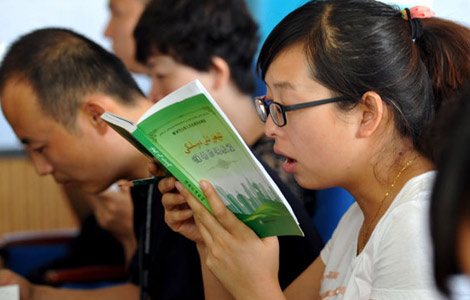Service sector drives up growth
Updated: 2013-08-06 01:06
By Chen Jia in Beijing and Yu Ran in Shanghai (China Daily)
|
|||||||||||
The service sector is tipped to replace the manufacturing industry and become the strongest driver of the Chinese economy.
Economists said China seems to be moving toward a more environmentally sustainable and less resource-intensive growth pattern, as the faster improvement of the service sector is in stark contrast with a sluggish manufacturing industry.
The British financial group HSBC reported on Monday that July's service purchasing managers index was 51.3, signaling a modest increase in business activity in the service sector.
New order growth in the sector rose to a five-month high as market demand increased. Employment in the sector also improved slightly, HSBC said.
The HSBC index reinforces the findings of the official non-manufacturing PMI data, released on Saturday — a reading of 54.1 in July, up from 53.9 in June.
"The current indicators suggest that non-manufacturing growth is stable and sound, providing a solid foundation to the overall economy," said Cai Jin, vice-chairman of China Federation of Logistics and Purchasing, which compiles the official non-manufacturing PMI data.
"It is a good start to the second half. We are confident of stabilizing growth and achieving the year's target, although there will be more challenges," he said.
Qu Hongbin, chief economist in China and co-head of Asian economic research at HSBC, showed more concerns about sustainable service growth in the near future.
"Although the service sector has maintained stable growth so far, the profit margin continues to be squeezed, given the divergence between input prices and prices charged."
"Without a sustained improvement of demand, service growth is likely to remain lackluster, putting downside pressures on employment growth," Qu said.
In contrast to the service sector, the HSBC manufacturing PMI stood at 47.7 in July, down from 48.2 in June, reaching an 11-month low and indicating an increasing rate of contraction of industrial businesses that face excessive production capacity.
The official manufacturing PMI data increased to 50.3 in July from 50.1 in June.
Chang Jian, a senior economist with Barclays Capital, said that despite the disappointing industrial performance, the service sector is becoming China's new growth engine and it has been "the bright spot" in the first half.
According to the National Bureau of Statistics, the service industry — the biggest employer in China — grew 8.3 percent from a year earlier in the first half, which was faster than the GDP growth rate. However, the manufacturing sector's growth was 7.6 percent.
Overall GDP growth slowed to 7.5 percent in the second quarter from 7.7 percent in the first, due to a slowdown in exports, factory production and investment.
Fixed-asset investment in the service sector increased 23.5 percent year-on-year for the first six months, faster than the 15.6 percent growth in the manufacturing sector, the NBS showed.
In the first six months, the service sector accounted for 45.3 percent of the GDP, while the manufacturing industry contributed 47.2 percent.
The government has set a target to lift the share of services in nominal GDP to 47 percent in the 12th Five-Year Plan (2011-15) from 43 percent in 2010.
Millions of businesses will see new opportunities during the period.
For instance, SAL Tours, a Shanghai travel agency, is benefiting from the fast expansion of the tourism market. All of the company's tours during the summer holiday were fully booked before the end of July, with an increase of more than 10 percent on cruises.
Ding Zhenyi, a sales manager at the travel agency, said that the demand for relaxing tours such as cruises, in-depth trips to specific destinations and booking services for individual tourists increased as Chinese people who get richer want to take it easy.
On July 30, top policymakers vowed to promote the development of emerging services and consumer services and accelerate the industrial structural transformation.
The central government announced a cut in production capacity in 19 industries in July, including steel, cement, copper and glass.
That suggests policymakers are prepared to restructure the economy and tolerate the necessary pain, analysts said.
"We believe service sector development is the supply side of the Chinese rebalancing equation," said Chang with Barclays Capital.
The development of the service sector is expected to strengthen domestic demand, particularly private consumption, and it can create more employment opportunities, particularly at the skilled and higher-income level, she said.
Contact the writers at chenjia1@chinadaily.com.cn and yuran@chinadaily.com.cn
Related Stories
Services sector grows, index shows 2013-08-05 16:00
China widens access in public services sectors 2013-08-01 09:26
Boost service sector to add jobs 2013-07-26 23:33
China to relax forex control over services trade 2013-07-25 09:33
Shanghai raises growth by emphasizing service 2013-07-24 07:20
Today's Top News
China central bank continues liquidity injection
Small firms should also think global
NBA courts Sina Corp
Govt to court private capital
Snowden obtains formal registration
EC denies delay in telecoms probes
Two more firms recall milk products
Japan's new warship draws fire
Hot Topics
Lunar probe , China growth forecasts, Emission rules get tougher, China seen through 'colored lens', International board,
Editor's Picks

|

|

|

|

|

|





